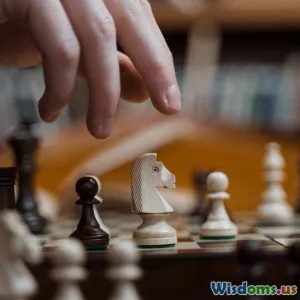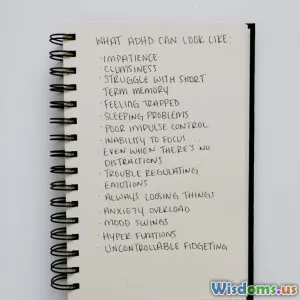
How Cognitive Biases Secretly Shape Daily Decision Making
9 min read Discover how cognitive biases covertly influence your daily decisions and strategies to overcome them for better choices. (0 Reviews)
How Cognitive Biases Secretly Shape Daily Decision Making
Every day, from the moment we wake up to the second we fall asleep, our brains process countless pieces of information, guiding decisions big and small. But lurking beneath our conscious awareness are invisible forces—cognitive biases—that subtly distort our judgment and influence how we navigate life. These biases often operate without us realizing it, quietly steering our choices far more than logic or facts.
Understanding these biases is not just academic; it’s a vital skill for better decision making, clearer thinking, and personal growth. This article delves deep into the fascinating world of cognitive biases, uncovering their mechanisms, presenting real-world examples, and empowering you to spot and counteract their effects.
What Are Cognitive Biases?
Cognitive biases are systematic patterns of deviation from rational judgment or objective standards of thought. They are mental shortcuts—heuristics—our brains adopt to process information quickly, especially in complex or uncertain situations. While these shortcuts can be efficient, they often lead us astray.
Origins and Purpose
The human brain is evolutionarily optimized for survival and speed, not necessarily for perfect logic. According to Nobel laureate Daniel Kahneman, these heuristics allow for fast decision-making but introduce error margins, especially in modern contexts that our ancestors never encountered.
For example, the availability heuristic makes us judge events as more likely if they are easily recalled, which once helped avoid danger but now may cause irrational fears, like overestimating the chance of plane crashes after media coverage.
Key Cognitive Biases That Shape Daily Decisions
Let’s explore some of the most impactful cognitive biases that shape everyday choices in ways you might not expect.
1. Confirmation Bias: Searching for Agreement
This bias leads us to favor information that confirms our existing beliefs and dismiss contradictory evidence. In daily life, this means once we hold an opinion, we often selectively seek out news, social media, or even conversations reinforcing that view.
Example: Suppose you believe a particular diet works best. You'll likely notice success stories about it while ignoring scientific studies showing mixed results, skewing your judgment.
This bias fuels polarization and undermines objective decision-making, making it hard to change minds or update knowledge.
2. Anchoring Bias: The Power of First Impressions
Anchoring occurs when an initial piece of information heavily influences subsequent judgments. This often happens in negotiations or pricing.
Example: If a product is initially priced at $100 but discounted to $70, consumers perceive it as a great deal even if $70 is still above market value.
A classic study showed that simply spinning a random number wheel influenced participants’ estimation of African countries in the United Nations, revealing how arbitrary anchors can skew facts.
3. Status Quo Bias: Preference for Familiarity
Many people prefer things to stay the same because changing requires effort, uncertainty, and risk.
Example: Employees may resist changing software systems even if a newer platform boosts productivity, simply because they are more comfortable with the current system.
This bias can hinder innovation and adaptation in both personal and professional arenas.
4. Loss Aversion: Fear of Losing Looms Larger than the Desire to Gain
Based on Prospect Theory by Kahneman and Tversky, people typically prefer avoiding losses rather than acquiring gains of the same value.
Example: Investors holding onto losing stocks too long hoping to avoid a loss consciously undermine their portfolio’s growth.
Loss aversion drives risk-averse behavior that sometimes results in missed opportunities.
5. Overconfidence Bias: Overestimating Our Own Abilities
Humans often have inflated confidence in their knowledge or skills, leading to suboptimal decisions.
Example: Drivers tend to rate themselves as above average, which statistically can’t be accurate for everyone and leads to risky driving behaviors.
Real-World Impact: How Biases Affect Daily Life
Beyond theories, cognitive biases affect everything from personal finance and health decisions to interpersonal relationships and workplace effectiveness.
Personal Finance
Studies reveal people often fall prey to mental accounting—treating money differently depending on its source or intended use, which can cause irrational spending or saving decisions.
For instance, a tax refund might get spent frivolously because it's perceived as 'bonus' money instead of part of the annual budget.
Health and Wellness
Biases like optimism bias cause individuals to underestimate risks (such as smoking or unhealthy eating), delaying preventative healthcare.
Relationships
Confirmation bias and attribution errors can poison relationships as we misinterpret partner behavior, holding onto negative beliefs without considering alternate explanations.
Workplace
Anchoring and status quo bias delay adopting better processes, while overconfidence can diminish collaboration and learning.
How to Recognize and Combat Cognitive Biases
Becoming aware of these biases is the first step toward mitigating their influence.
1. Expand Information Sources
Challenge confirmation bias by consciously seeking opposing viewpoints and diverse perspectives, especially on important decisions.
Actionable tip: When researching a topic, spend equal time reviewing critiques alongside supportive material.
2. Pause and Reflect
Our brain rushes to judgment. Taking a deliberate pause can reduce the impact of bias.
Actionable tip: Use techniques like the “10-minute rule” before making significant decisions.
3. Use Checklists and Frameworks
Structured decision-making tools minimize subjective influence and anchoring.
4. Accountability and Feedback
Discuss your decisions with trusted peers or mentors who can provide objective viewpoints.
5. Embrace Change Gradually
Recognize status quo bias and introduce small, incremental changes rather than all-or-nothing shifts.
Conclusion: Empowerment Through Awareness
Cognitive biases are an intrinsic part of how humans think. While they serve adaptive functions, ignoring their influence risks repeatedly making flawed decisions that affect our happiness, success, and relationships.
Understanding how these biases subtly and persistently shape daily choices empowers us to be more deliberate, informed, and flexible in thought. By cultivating self-awareness and implementing practical strategies to counter bias, we not only sharpen our decision-making skills but also embark on a path of continuous personal growth and better outcomes.
Remember the words of psychologist Richard Thaler: “It's only after we've made our mistakes that we can learn to improve.” Acknowledging and addressing cognitive biases is the key to learning and improvement in every area of life.
Make today the day you outsmart your biases.
References
- Kahneman, D. (2011). Thinking, Fast and Slow. Farrar, Straus and Giroux.
- Tversky, A., & Kahneman, D. (1974). Judgment under Uncertainty: Heuristics and Biases. Science, 185(4157), 1124-1131.
- Thaler, R. H. (2015). Misbehaving: The Making of Behavioral Economics. W. W. Norton & Company.
Rate the Post
User Reviews
Popular Posts




















